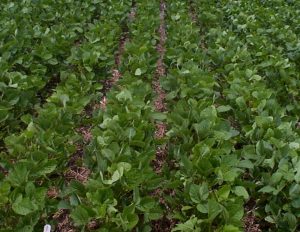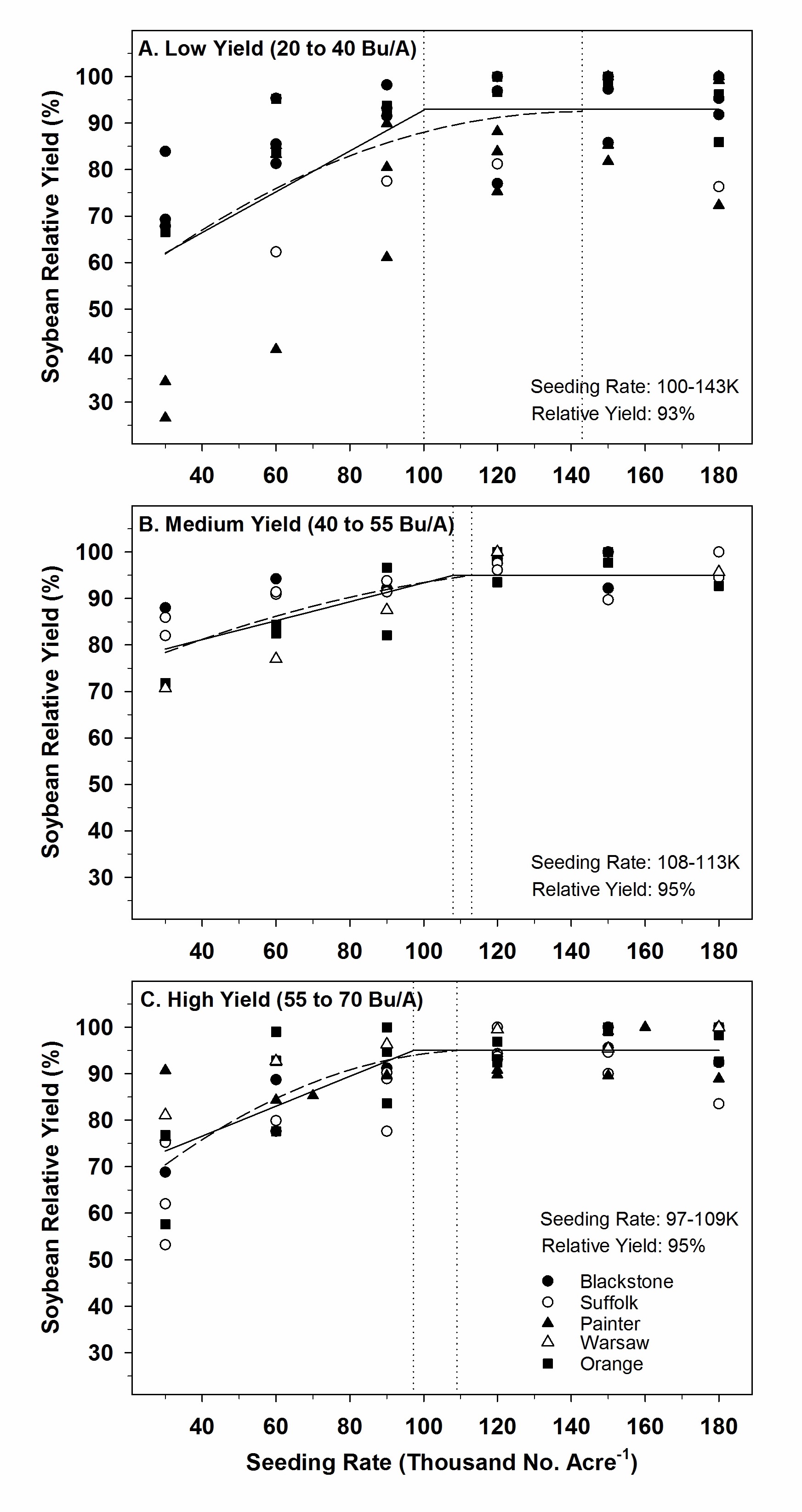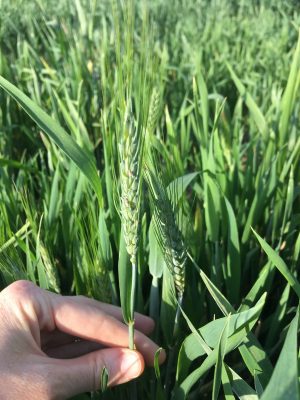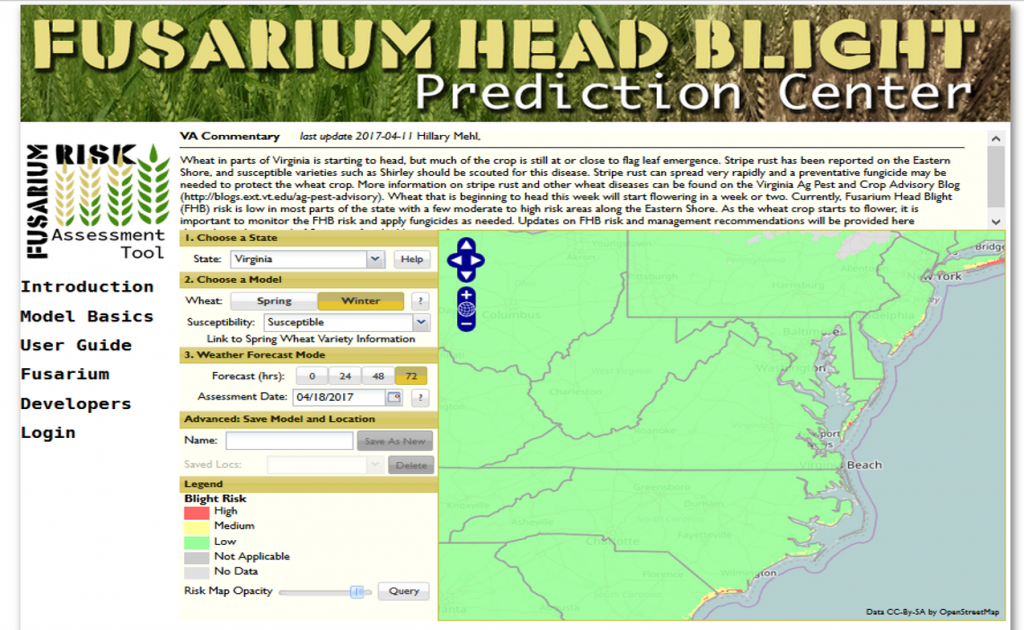Following last week’s rain, the risk for Fusarium head blight (FHB or scab) infections has increased, and the risk is very high even for moderately resistant varieties in certain portions of the state (see FHB Risk Map). Much of the wheat crop is beyond the early flowering stage, but for fields where wheat is currently flowering a fungicide may be needed to protect the crop from FHB infection and DON contamination. Recommended fungicides include Caramba, Prosaro, and Proline. Fungicides are most effective when applied at the start of flowering and up to a week later. The greatest coverage of the heads can be achieved by applying fungicides in 5 gal/A by air and 15 gal/A by ground with a 300-350 um droplet size and nozzles angled forward at least 30 degrees.
Category Archives: Commodity
Cotoran in Short Supply; What Are My Options for Ragweed?
Alan York, NC State Extension Weed Specialist
Charlie Cahoon, Virginia Tech Extension Weed Specialist
In the past few days, several people have told us that Cotoran is unavailable. Naturally, the conversation turned to alternatives.
Cotoran was once used almost universally on cotton. Prior to the mid-90’s, we basically told growers to buy the Cotoran first, and then buy the cotton seed. We felt Cotoran was that important. But, things have obviously changed in the past two decades, primarily because of Roundup Ready and LibertyLink. And, we have some additional PRE (preemergence) herbicides today. Although some growers still like and use Cotoran, the percentage of acres receiving Cotoran has decreased substantially.
A shortage of Cotoran is probably nothing to be highly concerned about. For most growers, glyphosate-resistant Palmer amaranth is the driver weed. And, frankly, Cotoran is not our best PRE herbicide for Palmer amaranth. However, in northeastern North Carolina and Virginia, glyphosate-resistant common ragweed is often more problematic than Palmer amaranth. And, as we have been saying in winter grower meetings, Cotoran is the material of choice for PRE ragweed control.
In the absence of Cotoran, what are the alternatives where common ragweed is an issue? Prowl, Staple, and Warrant have little to no activity on ragweed (see table below). Brake F16, Direx, and Reflex, on the other hand, may not be quite as effective on ragweed as Cotoran, but they should still provide good control. And, a mixture of Direx plus Reflex should be as good as Cotoran on ragweed. Brake F16 contains a mixture of fluridone plus the active ingredient in Reflex. Brake FX contains a mixture of fluridone plus the active ingredient in Cotoran. Brake FX is registered for sale in Virginia and North Carolina although Brake F16 seems to be the material being most promoted by the manufacturer. Brake FX should do a very good job on ragweed.
We had a trial in 2016 at a site heavily infested with common ragweed. The weatherman cooperated, and we could not have asked for better herbicide activation. Nevertheless, we had essentially complete ragweed control with Brake F16 and with combinations of Reflex + Direx, Reflex + Warrant, Direx + Warrant, and Direx + Staple. Knowing that Staple and Warrant are poor on ragweed, that leads us to believe that either Direx or Reflex would be good alternatives to Cotoran. If used alone, we suggest 1 pint of Reflex or 1.5 pints of Direx. If tank mixed, we would suggest 1 pint of Direx plus 12 to 16 ounces of Reflex.

Good common ragweed control by 1 pint/A Reflex. In the absence of Cotoran, Direx plus Reflex would be a wise choice for common ragweed control while also delaying PPO-resistance. Painter, VA 2016.
In this age of herbicide resistance, we routinely recommend at least two herbicides (two mechanisms of action) applied PRE. The exception is high organic matter soils where Warrant, and to a lesser extent Staple, are the only products that work. For mineral soils, and especially where Palmer amaranth is a problem, we will continue to recommend two or three mechanisms of action PRE. The goal is to hopefully prevent resistance to our PRE herbicides, especially Reflex, and to improve overall control.
Reflex is one of many PPO inhibitors being used in multiple crops. You have probably read in the farm press about the issues they are having in the Mid-South with PPO-resistant Palmer amaranth. At least some of their populations are resistant to PPO inhibitors applied PRE or POST. Obviously, we want to avoid that or at least delay its occurrence as long as possible in our area. To do that, we need multiple mechanisms of action PRE followed by an effective POST program.
Table 1. Weed response to preemergence cotton herbicides
So, what does that have to do with common ragweed? A ragweed population on the Virginia/North Carolina border has been confirmed as having multiple resistance to glyphosate, ALS inhibitors, and POST-applied PPO inhibitors. Brandon Schrage, a graduate student at NC State, is in the process of determining if that population is also resistant to PPO inhibitors applied PRE. Preliminary findings suggest it is. That should encourage us to use a tank mix of Direx + Reflex if common ragweed is our problem.
After the PRE application, we can control glyphosate-resistant ragweed escapes with timely applications of Liberty, XtendiMax or Engenia (XtendFlex cotton only), or Enlist Duo (Enlist cotton only). Envoke is also an option unless you expect ALS resistance.

Soybean Seeding Rates – How Low Can We Go?
It seems that everything that you read about soybean seeding rates is that we are planting too many seed. In general, I agree – at least for full-season soybean. We still seem to have that mindset that it takes 1 bag of seed per acre. But many of you have been listening and are taking the seeding rate down to 100,000 to 120,000 seed per acre, with no noticeable difference in yield. But, can you go lower? And how low can you go?
To help answer this question, we have re-analyzed about 10 years of data that we collected from dozens of experiments conducted from 2003 through 2011.  But instead of just looking at average yield response, we separated these responses into soybean yield potentials.
But instead of just looking at average yield response, we separated these responses into soybean yield potentials.
Why did we do this? I’ve always thought that more seed is needed to maximize yield on low-yielding fields (or portions of fields) and less seed are needed or high-yielding fields or portions of fields. Yes, this means that I’m asking you to spend more money on the least profitable fields and less money on the most profitable fields. Still, this strategy will likely be more profitable over all acres.
There are a few things worth noting about the graphs to the left. First, I’ve separated the data into low (20-40 Bu/A), medium (40-55 Bu/A), and high (55-70 Bu/A) groupings. We decided on these levels by analyzing the data over and over at many different yield levels. The resulting three levels were most stable and predictive.
Second, we used two statistical methods to fit a curve to the data to intentionally give us a range of seeding rates needed to maximize yield. This allow us to recognize the variability in the data and reflects our confidence in the response. Pay particular attention to the wide range of seeding rates necessary to maximize yield at the 20 to 35 bushel yield potential. This reflects the yield variability and the variability in the response of yield to seeding rates that are common in low-yielding years or fields. We just are not as confident in this set of data. Some years or locations, we could get by with 100,000 seed/acre; in others, it took more than 140,000. With the other yield potentials, the range is pretty tight. In other words, I have more confidence in recommending 110,000 or even less than 100,000 seed/acre in these instances.
Finally, we see that it takes, in general, less seed at high yields – which verifies my earlier statement that less seed are needed for higher yield potentials.
So what have I settled on? Below are my suggestions.
 But, you may ask, “What about yields greater than 70 bushels per acre? That’s a good question. But, I cannot answer it confidently since we have little data in that range. We are however conducting new experiments this summer to update our data.
But, you may ask, “What about yields greater than 70 bushels per acre? That’s a good question. But, I cannot answer it confidently since we have little data in that range. We are however conducting new experiments this summer to update our data.
But until that data is available, here are my thoughts. I think that lower seeding rates will work until you get to the 100+ bushel yield range. After that, I suspect that we are running low on reproductive nodes (node on the plant where pods can form). For instance, if we only have 80,000 plants/acre, we would need 15 reproductive nodes containing 4 pods on every one of these nodes! While this is possible, I’m assuming in this calculation that we will grow 2,500 seed/pound and 3.0 seed/pod. Taking that down to a more normal 2800 seed/pound and 2.5 seed/pod, that means we need 6 pods per node! I think that we are starting the expect a little much from single plant in this case.
So, for 100+ bushel yield environments, I’d suggest to gradually increase your seeding rate from the ones suggested above. I do understand that we have very few 100+ bushels fields, but I have seen parts of the field exceeding this when I’m watching a yield monitor. An we commonly have plots within our small-plot tests exceeding 90 and 100 bushels.
Finally, am I suggesting that we may be able to vary our soybean seeding rate as we do corn? Yes, I’m suggesting that. We will be validating some variable-rate-seeding (VRS) on two farmer’s fields this year. If you know of anyone who has VRS planters and who would like to participate in an on-farm test, let me know.
Virginia Potato Disease Advisory
The year’s first Virginia Potato Disease Advisory (by Dr. Steve Rideout), is attached as a pdf article: VPDAApril252017

Wheat Disease Update – April 20, 2017
Wheat is beginning to flower throughout Virginia, so it is time to make decisions about fungicide applications for both Fusarium head blight (FHB, also known as scab) and to protect the flag leaf as the grains begin to form. Currently, the risk for FHB is low in most parts of Virginia, even for susceptible varieties. The FHB Risk Assessment Tool can be found at http://www.wheatscab.psu.edu. Keep in mind that this is a prediction tool and it will not predict FHB outbreaks 100% of the time. A current screen shot of the website is shown below. Rains are expected over the weekend, but dry weather over the past several weeks has not favored spore production by the FHB fungus, so risk of FHB infection is expected to remain low for wheat that is flowering over the next week. However, now may still be the time to apply fungicides for foliar diseases including stripe rust, powdery mildew, and leaf blotch. The flag leaf must be protected during grain development to maximize yields. Again, due to the dry weather some areas have very little disease, and scouting is still recommended prior to making a fungicide application. However, there have been numerous reports throughout the region of outbreaks of stripe rust (especially on Shirley) and powdery mildew. Do NOT apply a strobilurin or fungicide pre-mix containing a strobilurin after flag leaf emergence (Feekes 9) since this can increase DON contamination in the grain. Prosaro, Caramba, and Proline are the most effective products for reducing scab and DON contamination, and these fungicides will also control foliar diseases such as leaf blotch, stripe and leaf rust, and powdery mildew. A fungicide efficacy table for wheat can be found in a previous post.
 Screen shots from the Fusarium Head Blight Risk Assessment Tool (http://www.wheatscab.psu.edu) on April 20, 2017. Currently, risk of FHB infection in wheat that is flowering is low in most parts of Virginia. The exception is along the Eastern Shore where conditions are typically more humid and favorable for spore production by the FHB fungus. For susceptible varieties such as Shirley, FHB risk is moderate to high in some areas. However, for moderately resistant varieties such as Hilliard, the risk is currently low. This illustrates the importance of variety selection in management of FHB and DON contamination in wheat.
Screen shots from the Fusarium Head Blight Risk Assessment Tool (http://www.wheatscab.psu.edu) on April 20, 2017. Currently, risk of FHB infection in wheat that is flowering is low in most parts of Virginia. The exception is along the Eastern Shore where conditions are typically more humid and favorable for spore production by the FHB fungus. For susceptible varieties such as Shirley, FHB risk is moderate to high in some areas. However, for moderately resistant varieties such as Hilliard, the risk is currently low. This illustrates the importance of variety selection in management of FHB and DON contamination in wheat.

Wheat Disease Identification Guide
Copies of a Wheat Disease Identification Guide from Kansas State are now available and can be requested from Dr. Hillary Mehl at the Tidewater AREC (hlmehl@vt.edu). A PDF version of the guide can be downloaded here. Though not specific to Virginia, many of the diseases included in the guide occur in our region and detailed descriptions of symptoms and management recommendations are included. As always, if confirmation of a disease is needed for wheat or other agronomic crops, plant samples can be submitted to the Virginia Tech Tidewater AREC (6321 Holland Rd. Suffolk, VA 23437). When submitting samples, be sure to fill out the Plant Disease Diagnostic Form with as much information as possible as this will assist us with an accurate diagnosis. The form can be downloaded here: Plant Disease Diagnostic Form

Wheat Disease Update – April 11, 2017
Though it is still a little early to be making scab fungicide applications, it is time to start thinking about if and when to apply a fungicide to the wheat crop. Wheat in parts of Virginia is starting to head, but much of the crop is still at or close to flag leaf emergence. Stripe rust was observed this week in Warsaw, VA and has been confirmed on the Eastern Shore of Virginia and in southeastern Delaware. Stripe rust is likely widespread in the state, and susceptible varieties such as Shirley should be scouted for this disease. Stripe rust can spread very rapidly and a preventative fungicide may be needed to protect the wheat crop. More information on stripe rust and other wheat diseases can be found in a previous post. Wheat that is beginning to head this week will start flowering in a week or two. Currently, Fusarium Head Blight (FHB) risk is low in most parts of the state with a few moderate to high risk areas along the Eastern Shore. As the wheat crop starts to flower, it is important to monitor the FHB risk and apply fungicides as needed. Updates on FHB risk and management recommendations will be provided here and from the FHB Alert system throughout the period of flowering for the Virginia wheat crop. You can sign up for FHB text message and/or email alerts here. Also be sure to check the FHB Risk Tool (http://www.wheatscab.psu.edu/) as the wheat crop starts to flower. If FHB risk is moderate to high, an application of a fungicide (e.g. Prosaro, Caramba) may be needed to protect the crop from scab and DON contamination. An update fungicide efficacy table for wheat can be downloaded here:
Section 18 authorized for Transform WG for control of sugarcane aphid on sorghum in Virginia
In accordance with Section 18 of the Federal Insecticide, Fungicide, and Rodenticide Act, the EPA has authorized the Emergency Exemption use of Transform WG (active ingredient = sulfoxaflor) to be used on sorghum to control sugarcane aphid (Melanaphis sacchari) in specified Virginia counties. The authorization will expire November 30, 2017. Foliar applications may be made at 0.75-1.5 oz/acre, with a maximum of 2 applications per acre per year. Please refer to the product’s Section 18 registration for further information, including application directions (at the time of this writing, the 2016 version of the Section 18 is the one available on cdms.net [the 2016 version expires on April 8]). Micah Raub and others with the Virginia Department of Agriculture and Consumer Services are acknowledged for their assistance.
Stripe Rust Confirmed in Wheat on the Eastern Shore of Virginia
On Friday, stripe rust was confirmed on a wheat sample from a field in Northampton County, Virginia. Steve Rideout, Extension Plant Pathologist at the Eastern Shore AREC, reported that infection is fairly severe and rainy conditions will favor the pathogen’s development. This is an early sighting for this disease and constitutes a serious threat to our wheat crop. The disease was found on Shirley, which based on observations in previous years in known to be highly susceptible to stripe rut. A previous post with management recommendations including variety susceptibility ratings and a fungicide efficacy table for stripe rust and other wheat diseases can be found here:
http://blogs.ext.vt.edu/ag-pest-advisory/stripe-rust-found-in-north-carolina-wheat/
You should be scouting your wheat crop at this time, and if stripe rust is found on a susceptible variety, a fungicide application is recommended. If you have any questions or need assistance identifying diseases on your wheat crop, contact Dr. Hillary Mehl at the Tidewater AREC (hlmehl@vt.edu).
EPA decision on chlorpyrifos
The head of the EPA, Scott Pruitt, signed an order last night denying the petition to ban chlorpyrifos (Lorsban). This decision will allow peanut growers in our area the continued use of this insecticide for the foreseeable future, perhaps until 2022 when the EPA is required to reevaluate safety of this product. The environmental group that filed the 2007 petition to ban chlorpyrifos has announced its plans to appeal the decision. More information can be found here – https://www.epa.gov/newsreleases/epa-administrator-pruitt-denies-petition-ban-widely-used-pesticide-0



